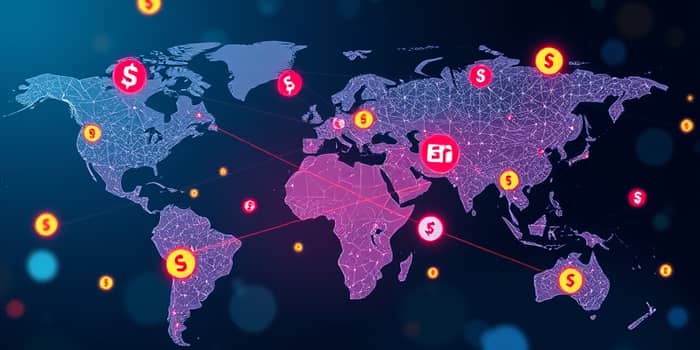In an age of global commerce and migration, the need to move money across borders swiftly and affordably has never been greater. By 2027, experts forecast projected $250 trillion by 2027 in international payment flows, up from $150 trillion in 2017. This staggering growth underscores the vital role cross-border transfers play in fueling trade, tourism, remittances, and everyday economic activity. Yet legacy systems often struggle under the weight of high fees, slow settlement times, and opaque processes.
Market Size and Economic Impact
The cross-border payments market is expanding at a remarkable pace, driven by global trade and consumer demand. With a compound annual growth rate of around 9%, the market is on track to reach $250 trillion by 2027. Meanwhile, the remittance sector alone hit $905 billion between June 2023 and June 2024, involving 771 million individual transactions.
These figures highlight how critical financial lifelines for developing nations and corporate balance sheets alike depend on efficient, reliable transfers. Remittances totaled $773 billion in 2021, with $605 billion funneled into low- and middle-income countries, often constituting a significant share of national GDPs. Simultaneously, B2B e-commerce sales are projected to soar to $36 trillion by 2026, reflecting a shift toward integrated global supply chains and cross-border trade powered by digital platforms.
Key Use Cases and Stakeholders
Cross-border payments serve a diverse cast of characters, each demanding unique features and service levels. From small exporters seeking predictable cash flow to migrant workers sending support home, the stakes could not be higher.
- Businesses: SMEs and large corporates managing complex supply chains.
- Consumers: Remittance senders, international travelers, and online shoppers.
- Financial institutions: Banks, neo-banks, and payment service providers.
- Regulators: AML, KYC and data privacy authorities enforcing compliance.
Major Challenges and Frictions
Despite technological advances, several barriers continue to hamper seamless global transfers. High costs, sometimes representing 5–10% of transfer value, eat into recipient funds. Speed remains a pain point: legacy networks may take days rather than hours to settle payments, and tracking updates are often limited.
Regulatory fragmentation compounds these issues. Variations in anti-money laundering rules, tax requirements, and data privacy standards across jurisdictions create compliance headaches for service providers. Volatile exchange rates and conversion fees further inflate prices and complicate transaction workflows.
- High transaction fees and hidden charges.
- Slow settlement times and opaque tracking.
- Regulatory complexity and data privacy hurdles.
- Currency conversion volatility and extra costs.
Regulatory Landscape and Recent Developments
Regulators are responding to consumer demands and technological change by tightening frameworks and fostering harmonization. Global bodies like the Financial Action Task Force (FATF) have updated anti-money laundering and counter-terrorism financing standards, while the EU’s GDPR and Brazil’s LGPD enforce stringent data privacy rules.
In 2024, the Financial Stability Board released recommendations to streamline cross-border payment data, and the newly established Forum on Cross-Border Payments Data (2025) aims to promote consistent data formats. Enhanced inter-jurisdictional cooperation is improving risk assessment and law enforcement collaboration, and consumer protection measures now require clear, upfront fee disclosures and real-time transaction updates.
Technological Innovations Driving Change
Emerging technologies are transforming how payments move across borders. SWIFT gpi offers near real-time transaction tracking, cutting settlement times from days to mere hours. Domestic real-time systems like Brazil’s Pix and Singapore’s RTP are expanding internationally through initiatives such as Project Nexus by the Bank for International Settlements, which aims to interlink national payment rails.
The adoption of ISO 20022 messaging enriches transaction data, improving transparency, interoperability, and compliance. AI and automation accelerate KYC/AML checks and fraud detection, while blockchain and stablecoins present promising alternatives for low-cost, instantaneous transfers, albeit with gradual uptake. Fintech disruptors now command up to 65% of the global P2P transfer market, challenging traditional banks to innovate or forge strategic alliances.
Best Practices for Businesses and Financial Institutions
To navigate this evolving environment, payment providers and corporates are adopting a range of best practices that enhance efficiency and customer satisfaction.
- Implement automated real-time compliance tools for KYC and sanction screenings.
- Form strategic partnerships with fintechs to access innovative rails and APIs.
- Continuously monitor regulatory changes and tailor solutions to local requirements.
- Provide transparent fee disclosures and robust payment tracking portals.
Key Numbers and Projections
Future Outlook: Towards Frictionless Global Payments
The path to truly seamless cross-border payments lies in further cost reduction, interoperability, and access expansion. Initiatives like Project Nexus and ISO 20022 adoption will link national real-time payment systems, while AI-driven compliance and blockchain innovations will enhance speed and transparency.
Addressing underserved markets and corridors remains critical. Reducing fees for remittances and SME transfers, improving consumer protection, and standardizing data requirements across jurisdictions will unlock new economic opportunities and foster financial inclusion worldwide.
Conclusion: Vision for Simplified Transactions
Cross-border payments underpin global commerce, financial stability, and personal livelihoods. While significant progress has been made, persistent frictions in cost, speed, and regulatory complexity demand ongoing innovation and cooperation. By embracing cutting-edge technology, harmonizing standards, and prioritizing customer-centric services, the industry can realize a future where sending money across borders is as effortless as domestic transfers, driving prosperity and connection in every corner of the world.
References
- https://www.fsb.org/2025/05/forum-on-cross-border-payments-data-convenes-for-the-first-time/
- https://conduitpay.com/blog/7-cross-border-payment-trends-to-watch-in-2025
- https://navigate.visa.com/europe/research-and-insights/the-past-present-and-future-of-cross-border-money-movement/
- https://www.aiprise.com/blog/cross-border-payment-regulations-global-transactions
- https://www.weforum.org/stories/2025/01/cross-border-payments-economic-growth/
- https://www.fsb.org/2024/12/recommendations-for-regulating-and-supervising-bank-and-non-bank-payment-service-providers-offering-cross-border-payment-services-final-report/
- https://www.rapyd.net/blog/cross-border-payment-trends/
- https://www.independentbanker.org/article/2025/09/01/what-should-community-banks-know-about-cross-border-payments










